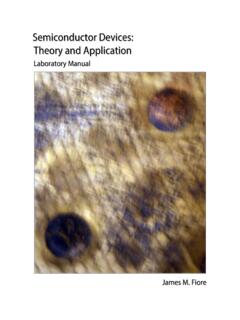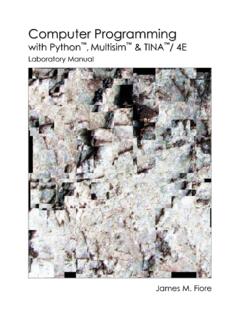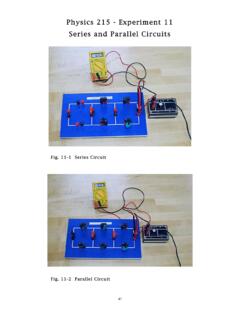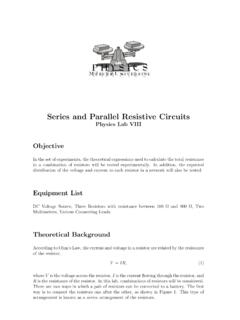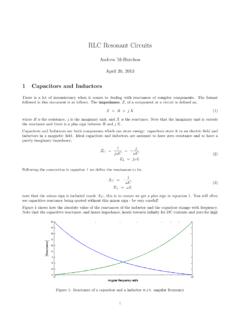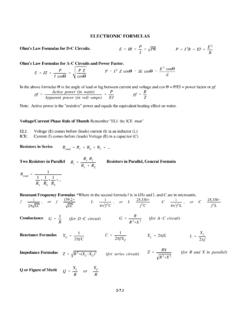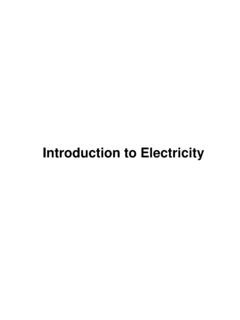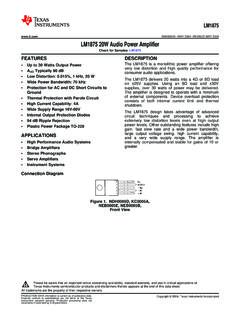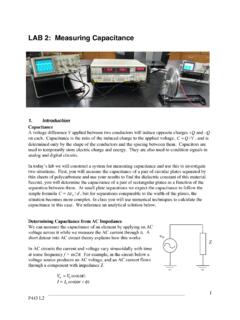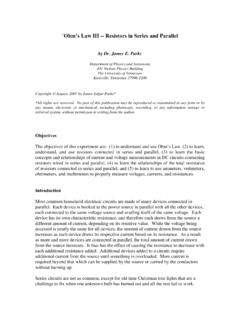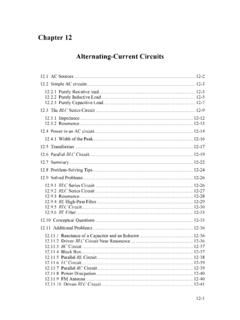Transcription of AC Electrical Circuit Analysis
1 AC Electrical Circuit Analysis AC Electrical Circuit Analysis A Practical ApproachA Practical ApproachJames M. FioreJames M. Fiore 2 AC Electrical Circuit AnalysisAC Electrical Circuit AnalysisA Practical ApproachA Practical Approach by James M. Fiore Version , 22 April 20213 This AC Electrical Circuit Analysis , by James M. Fiore is copyrighted under the terms of a Creative Commons license: This work is freely redistributable for non-commercial use, share-alike with attribution Device data sheets and other product information are copyright by their respective ownersand have been obtained through publicly accessible manufacturer's web by James M. Fiore via dissidents ISBN13: 979-8605022282 For more information or feedback, contact:James Fiore, ProfessorElectrical Engineering TechnologyMohawk Valley Community College1101 Sherman DriveUtica, NY 13501 the latest revisions, related titles, and links to low cost print versions, go to: or my mirror sites and Channel: Electronics with Professor FioreCover art, Chapman's Contribution Redux, by the author 4 IntroductionIntroductionWelcome to the AC Electrical Circuit Analysis , an open educational resource (OER).
2 The goal of this text is to introduce the theory and practical application of Analysis of AC Electrical circuits. It assumes familiarity with DCcircuit Analysis . If you have not studied DC Circuit Analysis , it is strongly recommended that you read the companion OER text, DC Electrical Circuit Analysis before continuing. Both texts are offered free of charge under a Creative Commons non-commercial, share-alike with attribution license. For your convenience, along with the free pdf and odt files, print copies are available at a very modest charge. Check my web sites for text is based on the earlier Workbook for AC Electrical Circuits, which it replaces. The original expository text has been greatly expanded and includes many examples along with computer simulations. For the convenience of those who used the Workbook, many of the problem sets are the same, with some re-ordering depending on the you are already familiar with DC Electrical Circuit Analysis , the format of this title is similar.
3 This text picks up where the DC text leaves off; beginning with AC concepts such as sinusoidal waveforms, basic Fourier decomposition of complex waveforms, complex numbers and the like. Also, reactance and impedance are introduced along with phasor diagrams. Chapters on series , parallel and series - parallel RLC circuits commence. Following these, network theorems along with nodal and mesh Analysis are discussed for the AC case. The text completes with chapters on AC power, resonance, and introductions to polyphase systems and magnetic circuits. Each chapter begins with a set of learning objectives and concludes with practice exercises that are generally divided into four major types: Analysis , design, challenge and simulation. Many SPICE-based Circuit simulators are available, both free and commercial, that can be used with this text. The answers to most odd-numbered exercises can be found in the Appendix.
4 A table of standard resistor sizes is also in the Appendix, which is usefulfor real-world design problems. If you have any questions regarding this workbook, or are interested in contributing to the project, do not hesitate to contact text is part of a series of OER titles in the areas of electricity, electronics, audio and computer programming. It includes three other textbooks covering semiconductor devices, operational amplifiers, and embedded programming using the C language with the Arduino platform. There is a text covering DC Electrical circuits similar to this one, and also seven laboratory manuals; one for each of the five texts plus individual titlescovering computer programming using the Python language, and the science of sound. The most recent versions of all of my OER texts and manuals may be found at my MVCC web site as well as my mirror site: This text was created using several free and open software applications including Open Office, Dia, SciDAVis, and thanks to the following individuals for their efforts in reviewing and proofreading the DC and AC Electrical Circuit Analysis texts: Glenn Ballard, John Markham, Jo o Nuno Carvalho, Mark Steffka and Jim the Have-nots and the Has-beens Well, the people, I would say.
5 There is no patent. Could you patent the sun? Jonas Salk, inventor of the polio vaccine,when asked who owns the patent to of ContentsTable of ContentsChapter 1: Chapter Sinusoidal Basic Fourier Complex Reactance and Phasor 39 Chapter 2: series RLC Chapter The series series series Circuit Concerning Practical 64 Chapter 3: parallel RLC Chapter The parallel parallel parallel Circuit 4: series - parallel RLC Chapter The series - parallel series - parallel series - parallel Circuit 1337 Chapter 5: Analysis Theorems and Chapter Source Superposition Theorem .. Th venin's and Norton's Maximum Power Transfer Delta-Y (Pi-T) 187 Chapter 6: Nodal and Mesh Chapter Nodal Mesh Dependent 242 Chapter 7: AC Chapter Power Power Power 287 Chapter 8: Chapter series parallel 3318 Chapter 9: Polyphase Chapter Polyphase Three-Phase Power Factor 365 Chapter 10: Decibels and Bode Chapter The Bode Combining the Elements - Multi-Stage 396 AppendicesA: Standard Component : Methods of Solution of Linear Simultaneous : Equation : Answers to Selected Odd-Numbered : Questions for Selected Odd 1 Chapter Learning Chapter Learning ObjectivesAfter completing this chapter, you should be able to: Describe sinusoidal waveforms in mathematical terms.
6 Express complex waveforms using basic Fourier Analysis . Perform mathematical operations using complex numbers. Draw phasor diagrams for complex numbers. Compute and plot capacitive and inductive reactance as a function of frequency. Compute and plot complex impedance as a function of frequency. Describe the relationships between resistance, reactance, impedance, conductance, susceptance and IntroductionIn this chapter we begin our study of alternating current, or AC, Electrical Circuit Analysis . As such, this chapter is filled with foundational material that will be used in the remainder of this text. It is critical that the concepts presented here be fully understood in order to achieve success in later chapters. We start with the mathematical description of the most simple AC waveform, the sine wave. This includes parameters such as amplitude, frequency, period, phase and DC offset.
7 From there we discover how to describe other waveforms in terms of combinations of sine waves, and also how to determine the effective, or DC equivalent, value of a sine wave. ACanalysis is practically impossible to perform without the use of complex numbers, and discussion follows with their description and proper manipulation. Finally, we introduce the concepts of reactance and impedance, and how they relate to resistance. This includes examination using both frequency domain plots and phasor diagrams. Phasor diagrams are vector plots and can be used to show the relationships between various voltages in a Circuit , as well as between currents or resistive /reactive of the topics in this text will echo your studies in DC Circuit Analysis , such as Ohm's law, Kirchhoff's voltage and current laws, series - parallel Analysis , nodal Analysis , and the like.
8 Thus many concepts will be familiar. The major practical difference is that all quantities in DC systems are scalars, that is, they have only magnitude. In contrast, AC quantities are vectors, and thus have both magnitude and direction (or more properly,phase). Consequent;y, mathematical operations such as addition or multiplication have to follow vector rules instead of scalar rules. Forgetting to do so is a common error for students new to the subject and one that will bring no end of grief. These rules will be reviewed in the section covering complex numbers. Make sure that you have this material mastered before proceeding. Sinusoidal Sinusoidal WaveformsAC, or alternating current, is so named because the current alternates or flips back and forth between two polarities. In other words, the current (and consequently the voltage) is a function of time.
9 This is fundamentally different from direct current thatis fixed in polarity and generally constant over time. A laboratory DC voltage source,for example, ideally maintains a set voltage across its terminals and does not vary over time. In contrast, as an AC waveform swings back and forth through time, its shape can exhibit wide variations ranging from the simple, regular paths of laboratory standards such as sine waves, triangle waves and square waves, to the far more complex and undulating waveforms produced by musical instruments and the human voice. The sine wave is the simplest wave that may be created. It represents the motion of asimple vector rotating at a constant speed, such as the vertical displacement of the second hand of a clock. An example is shown in Figure The horizontal axis plotstime. It increases as we move from left to right ( , if point A is to the right of point B, then A occurs later in time than does B).
10 The vertical axis is represented here in general as a percentage of maximum but would ordinarily be a measurement of voltage, current, sound pressure, or the like. Note the smooth variation that starts at zero, rises to a positive peak one quarter way through, falls back to zero when halfway through, continues to a negative peak threequarters through, and then rises again to where it started. This process then repeats. Each repeat is referred to as a cycle. In Figure , one complete cycle is shown. 11 Figure sine WavePercentage of Peak-100-80-60-40-20020406080100 Time (cycles) waves exhibit quarter wave symmetry. That is, each quarter (in time) of the wave is identical to any other if you simply flip it around the horizontal axis and/or rotate it upright about its peak. The time it takes to complete one cycle is called the period and is denoted with the symbol T (for Time).
